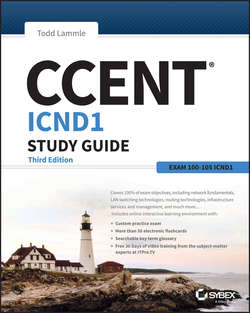Читать книгу CCENT ICND1 Study Guide - Lammle Todd - Страница 16
Chapter 1
Internetworking
Internetworking Models
ОглавлениеFirst a little history: When networks first came into being, computers could typically communicate only with computers from the same manufacturer. For example, companies ran either a complete DECnet solution or an IBM solution, never both together. In the late 1970s, the Open Systems Interconnection (OSI) reference model was created by the International Organization for Standardization (ISO) to break through this barrier.
The OSI model was meant to help vendors create interoperable network devices and software in the form of protocols so that different vendor networks could work in peaceable accord with each other. Like world peace, it’ll probably never happen completely, but it’s still a great goal!
Anyway the OSI model is the primary architectural model for networks. It describes how data and network information are communicated from an application on one computer through the network media to an application on another computer. The OSI reference model breaks this approach into layers.
Coming up, I’ll explain the layered approach to you plus how we can use it to help us troubleshoot our internetworks.
Goodness! ISO, OSI, and soon you’ll hear about IOS! Just remember that the ISO created the OSI and that Cisco created the Internetworking Operating System (IOS), which is what this book is all-so-about.
The Layered Approach
Understand that a reference model is a conceptual blueprint of how communications should take place. It addresses all the processes required for effective communication and divides them into logical groupings called layers. When a communication system is designed in this manner, it’s known as a hierarchical or layered architecture.
Think of it like this: You and some friends want to start a company. One of the first things you’ll do is sort out every task that must be done and decide who will do what. You would move on to determine the order in which you would like everything to be done with careful consideration of how all your specific operations relate to each other. You would then organize everything into departments (e.g., sales, inventory, and shipping), with each department dealing with its specific responsibilities and keeping its own staff busy enough to focus on their own particular area of the enterprise.
In this scenario, departments are a metaphor for the layers in a communication system. For things to run smoothly, the staff of each department has to trust in and rely heavily upon those in the others to do their jobs well. During planning sessions, you would take notes, recording the entire process to guide later discussions and clarify standards of operation, thereby creating your business blueprint – your own reference model.
And once your business is launched, your department heads, each armed with the part of the blueprint relevant to their own department, will develop practical ways to implement their distinct tasks. These practical methods, or protocols, will then be compiled into a standard operating procedures manual and followed closely because each procedure will have been included for different reasons, delimiting their various degrees of importance and implementation. All of this will become vital if you form a partnership or acquire another company because then it will be really important that the new company’s business model is compatible with yours!
Models happen to be really important to software developers too. They often use a reference model to understand computer communication processes so they can determine which functions should be accomplished on a given layer. This means that if someone is creating a protocol for a certain layer, they only need to be concerned with their target layer’s function. Software that maps to another layer’s protocols and is specifically designed to be deployed there will handle additional functions. The technical term for this idea is binding. The communication processes that are related to each other are bound, or grouped together, at a particular layer.
Advantages of Reference Models
The OSI model is hierarchical, and there are many advantages that can be applied to any layered model, but as I said, the OSI model’s primary purpose is to allow different vendors’ networks to interoperate.
Here’s a list of some of the more important benefits of using the OSI layered model:
■ It divides the network communication process into smaller and simpler components, facilitating component development, design, and troubleshooting.
■ It allows multiple-vendor development through the standardization of network components.
■ It encourages industry standardization by clearly defining what functions occur at each layer of the model.
■ It allows various types of network hardware and software to communicate.
■ It prevents changes in one layer from affecting other layers to expedite development.
